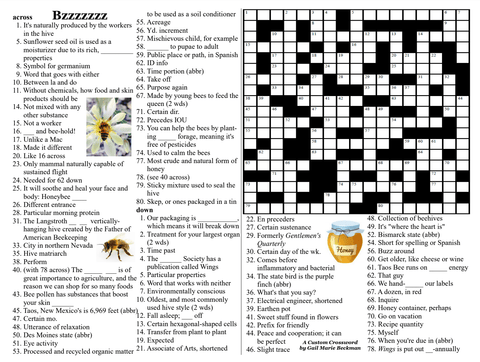Save the Bees
|
We in the US are currently witnessing a worrisome decrease in the population of honey bees…yes, honey bees. Honey bees may sting in auto-defense, so some of us have a fear of them, but they are not aggressive in your midst, and they are of great importance to agriculture. They are one key reason we are able to go to the grocery store to buy such an abundance of food. Bees and their dedicated work are essential in the first steps of successful agriculture as they pollinate 71 of the 100 crops that provide 90% of the world’s food. Foods that rely heavily on honey bee pollination include almonds, strawberries, apples, and alfalfa to feed dairy cows, and so much more. Without the bees, we will lose access to some of our favorite foods. |
Taos Bee Crossword Giveaway! |
|
Bee keepers report losing up to 30% of their honey bees each winter in recent years. There are several things that could contribute to this outcome; climate change, habitat loss, and parasites. But the most devastating killer is a group of insecticides known as neonicotinoids or neonics. Neonics, often coated on seeds, like corn and soybeans, before planting, are detrimental to the purity of the plant crops, which is bad news for us, but worse for the bees. This potent toxin has resulted in decreased reproduction and collapsed hives in areas where bees did not have access to a wide array of available non-treated forage, like gardens and wildflower fields, in addition to the treated crops. One of the best ways you can help the bees is to plant clean forage for them. Clean forage is free of insecticides. Forage includes all sorts of flowering trees and plants. If you need clean alternatives to using a weed killer an keep our pollinators safe check out this page https://www. Below is a map from the Xerces Society which lists the plants bees love in your area! At Taos Bee, every year, we donate at least 1% of our annual sales to organizations dedicated to protecting, preserving and restoring the natural environment and saving the bees |
|
Clicking on the map will take you to the Pollinator Conservation Resource Center, where you can find regional information about plant lists, habitat conservation guides, and more. To access national resources including plant lists, conservation guides and fact-sheets, information on native bee nests, pesticides, bee identification and policy documents such as the US federal pollinator strategy, visit the US & Canada Pollinator Conservation Resources page. For questions or comments about the Resource Center, or to suggest additional content, please email pollinators@xerces.org. |


